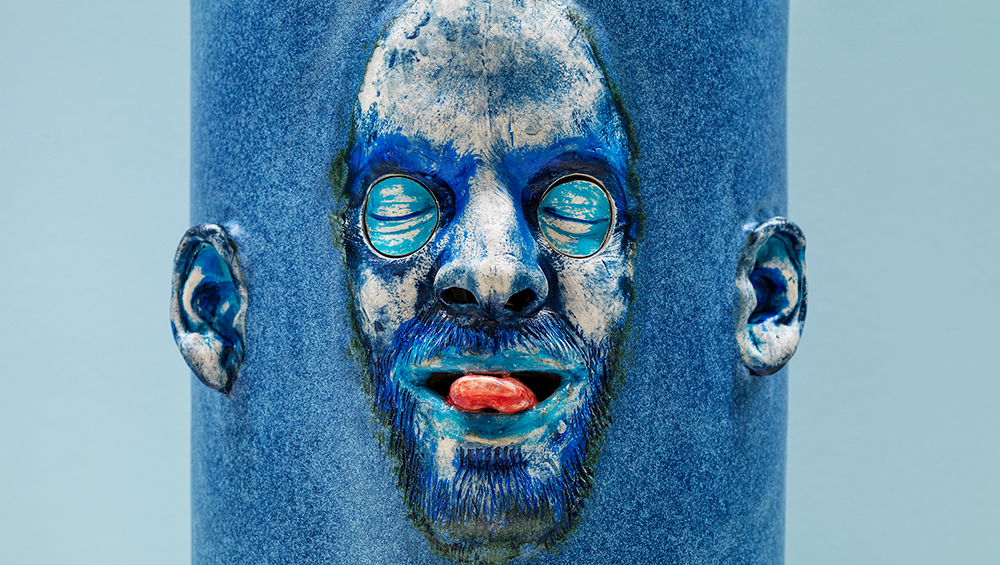
Jonathan Baldock, They tried to bury me, They didn't realise I was a seed, 2023 (detail). Courtesy the artist and Stephen Friedman Gallery. Photo © Mark Reeves, courtesy YSP.
Yorkshire Sculpture Park
23 September 2023 – 7 July 2024
by VERONICA SIMPSON
Jonathan Baldock (b1980, Kent) is having quite a moment. In October 2022, his tall ceramic totems - some sandwiching and squishing, some adorned with, limbs, tongues and ears, ropes, buckets and basketry - were the first artworks to greet visitors in the Hayward Gallery’s show Strange Clay: Ceramics in Contemporary Art. Accompanied by a whimsical soundtrack of burps and burbles, farts and fizzes, his Hayward installation played with your preconceptions, as did the rest of the ambitious exhibition in praise of this most malleable of materials.
In September 2023, he was given one of two solo presentations for the opening of a new art space in Lewes, programmed by the curatorial team at Charleston (the modernist East Sussex house and gallery that was once home to Bloomsbury set artists Vanessa Bell and Duncan Grant). Now, Baldock’s quirky but profoundly resonant forms fill the Weston Gallery of the Yorkshire Sculpture Park (YSP). This time, the works have been commissioned and made in response to this space, and what a difference that makes. It magnifies the sense of dialogue between the works and their surroundings.
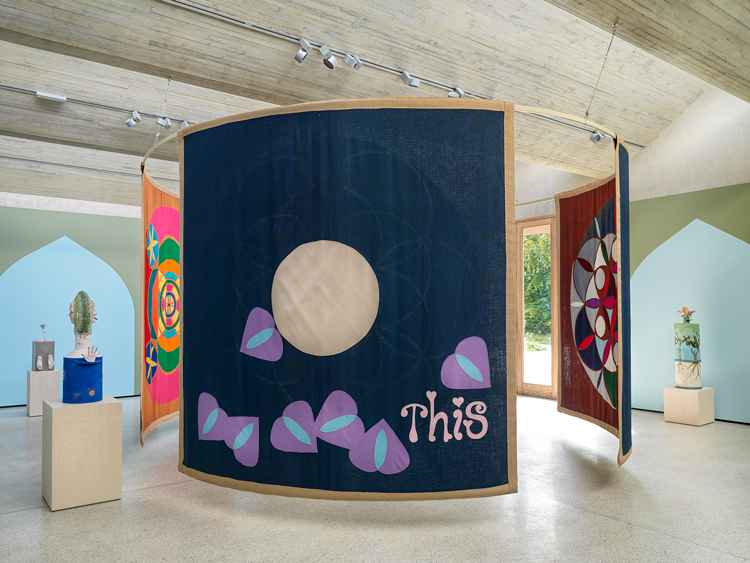
Jonathan Baldock, Touch Wood, installation view at Yorkshire Sculpture Park, 2023. Courtesy the artist and Stephen Friedman Gallery. Photo © Mark Reeves, courtesy YSP.
The Weston was designed by architects Feilden Fowles (and shortlisted for the Stirling Prize in 2019) and there is a wonderful mix of ancient and modern in the building, which is set into a hillside overlooking the park. The gallery combines thick, rammed earth walls punctuated with large, timber-framed windows looking on to the windswept Yorkshire landscape, with multiple long rooflights inserted between sculpted concrete curving rafters. Baldock’s response has been to immerse us in his own portfolio of ancient and modern forms, inspired by a heady mix of myths and rituals, from harvest festivals to folk art, medieval church carvings to queer graffiti.
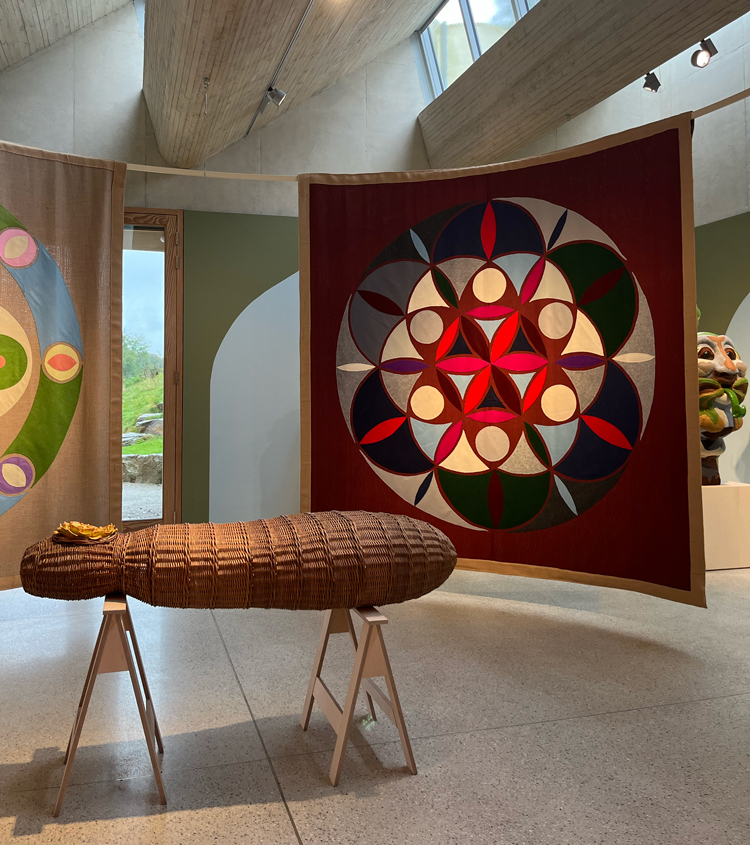
Jonathan Baldock, Touch Wood. Installation view, Yorkshire Sculpture Park, 2023. Photo: Veronica Simpson.
In fact, he has created a temple to rural and pagan typologies, part sanctuary, part reliquary. There is even a coffin – a pupa-shaped form woven from wicker, bearing a ceramic hop blossom where the face would be (one of several references to the generations of hop pickers from whom Baldock is descended). It is placed horizontally in the centre of a circular space delineated by four large, hanging textile banners. These feature sacred geometries on the inside, each banner’s palette inspired by the four seasons. On the outside they have one symbol apiece – a flower that buds, blooms, then sheds its petals in sync with the season represented on its reverse. A single word adorns the dark blue background on each, spelling out the phrase: You enrich this world. This quote is taken from transgender rights activist Shon Faye’s book The Transgender Issue: An Argument for Justice.
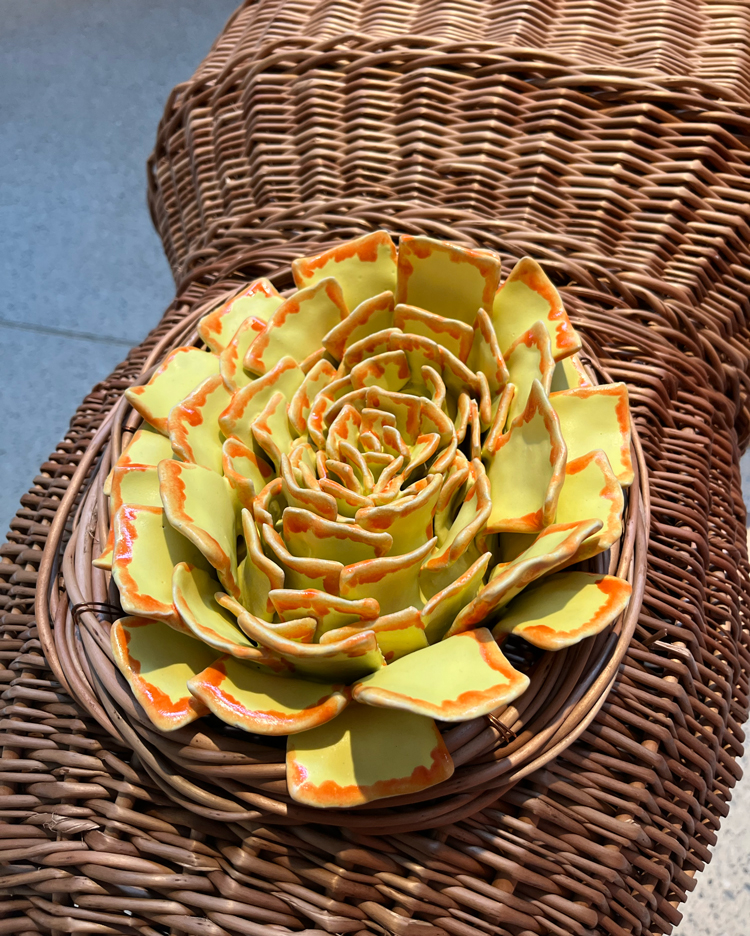
Ceramic hop flower on coffin lid. Installation view, Jonathan Baldock, Touch Wood, Yorkshire Sculpture Park, 2023. Photo: Veronica Simpson.
YSP’s senior curator, Sarah Coulson, says: “One of the first titles of the show was Secrecy is Safety. It’s referencing the Aids crisis and the propaganda of ‘silence equals death’. But if you are hidden away, sometimes that can make you safe. It’s a double-edged sword. By bringing these hidden things out into view, Jonathan is giving them space and making it a very fluid and queer space.”
Speaking of revealing that which is usually hidden, at least three pieces are directly inspired by 15th-century figures carved into the misericords Baldock discovered while nosing around Wakefield Cathedral in his research. Misericords are shelves or folding seats set deep into the church beyond the view of the public, designed to offer rest for the choir or clergy during long services. Because the misericords were tucked out of sight, the medieval craftsmen who worked on them were able to give full rein to their cheeky invention, as we see (literally) in the “tumbler”, a figure peeking between bare buttocks through his parted, upturned legs; Baldock’s version is titled Be Fruitful and Multiply (2023).
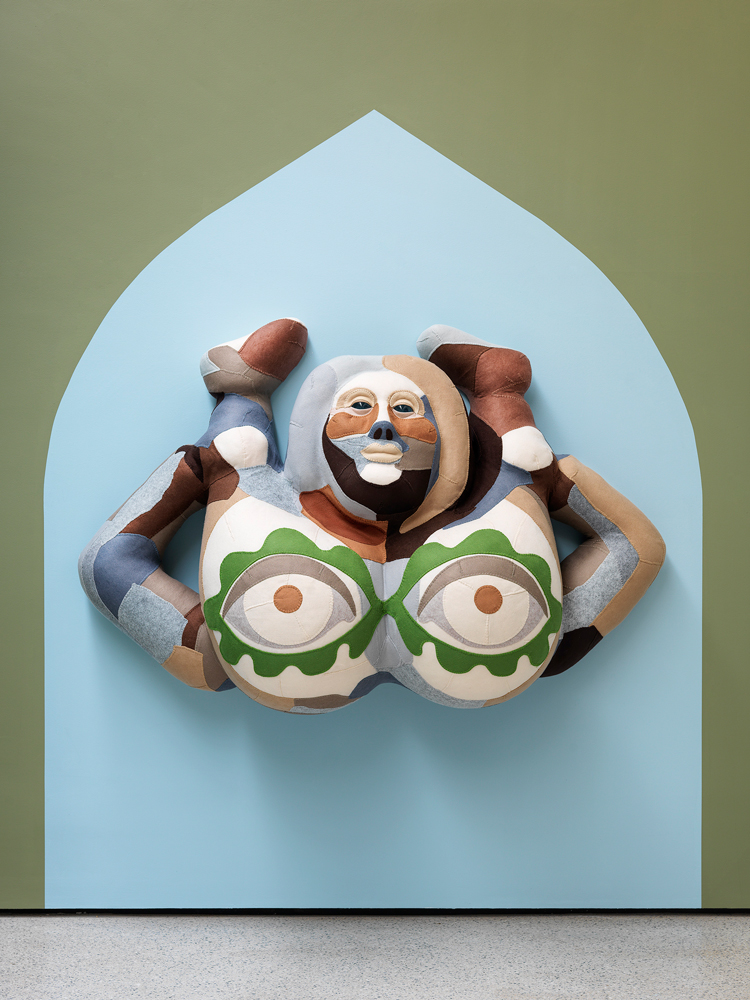
Jonathan Baldock, Be fruitful and multiply, 2023. Courtesy the artist and Stephen Friedman Gallery. Photo © Mark Reeves, courtesy YSP.
This work, like many here, demonstrates Baldock’s textile artistry, in addition to his prowess with ceramics. The original carved wooden figures (depicted in photographs available in the gallery) were shot from every angle and then digitally processed to yield an exact, albeit massively enlarged, replica in polystyrene, which was coated with wadding and padding and then clad in applique designs, blanket-stitched in felted wool. While Baldock has painstakingly recreated the contours of the cathedral’s carved decorations, he has added his own uplifting palette of greens, greys and creamy whites.
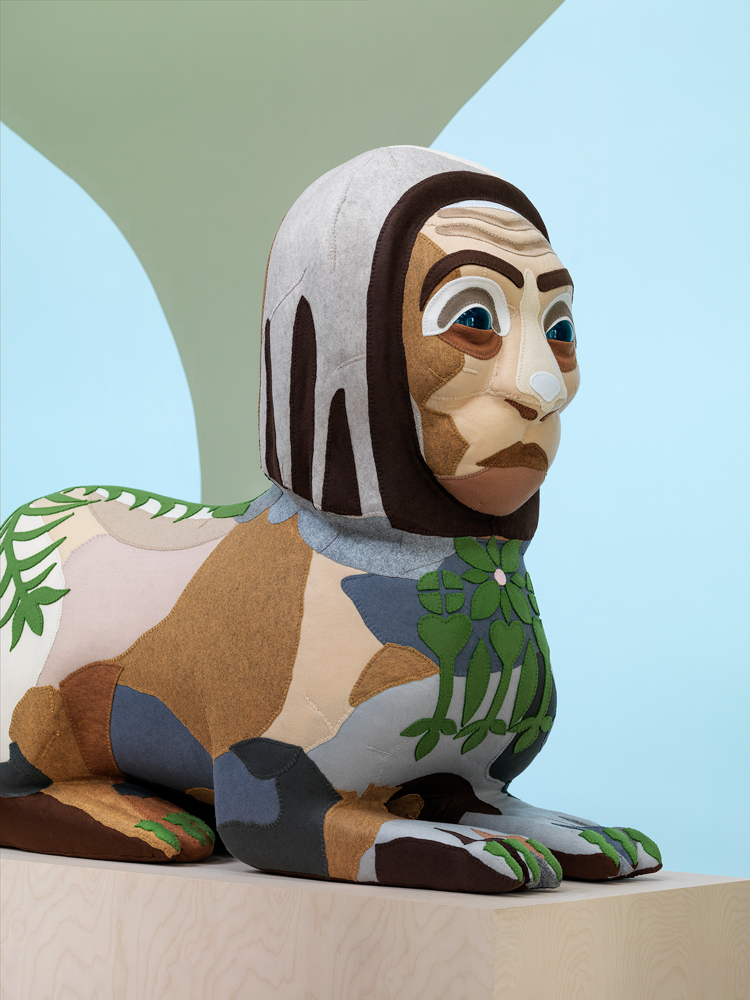
Jonathan Baldock, Patience, 2023. Courtesy the artist and Stephen Friedman Gallery. Photo © Mark Reeves, courtesy YSP.
They seem filled with life yet strangely toy-like. Further animation comes when sunlight hits the crystal orbs Baldock has used for eyeballs for the tumbler, the sphynx-like creature Patience (2023) and the double-headed lion figure, aptly titled No One had Paid them Any Particular Attention (2023), which glitter when the sun penetrates the rooflights.
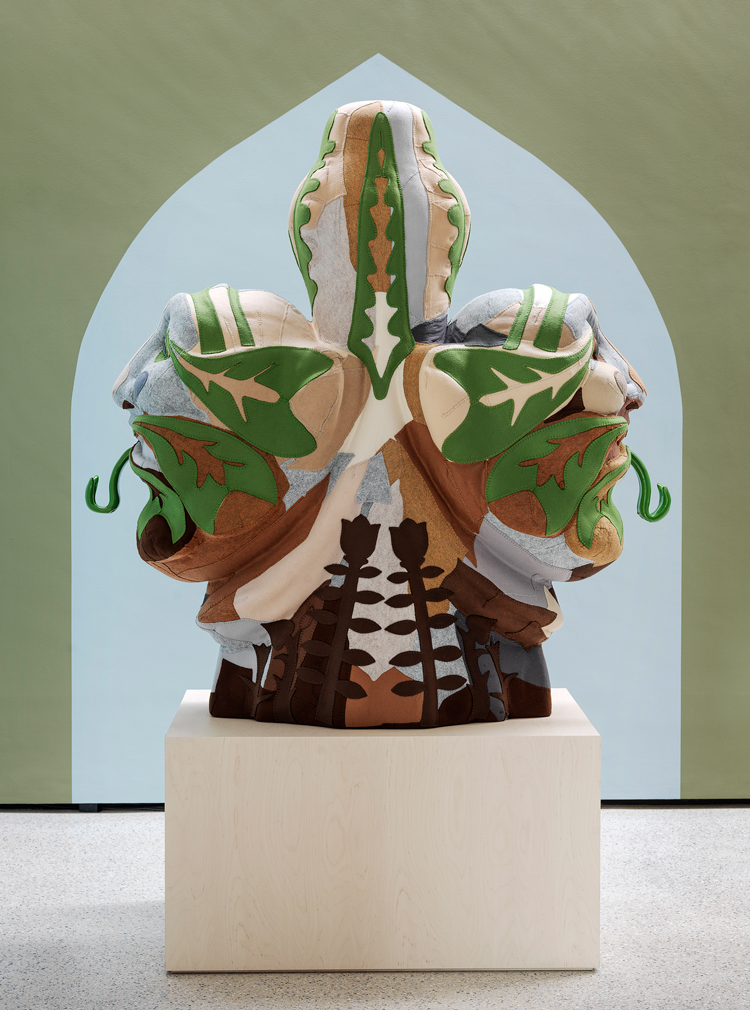
Jonathan Baldock, No one had paid them any particular attention, 2023. Courtesy the artist and Stephen Friedman Gallery. Photo © Mark Reeves, courtesy YSP.
Coulson says: “He was thinking about harvest festivals and what are we offering and to whom.” She gestures to the “green man”, a ceramic pillar with a face peeping through a corset of bark-like ridges, with his tongue out – the saucy or irreverent protruding tongue is a favourite Baldock motif. A plate on top of the pillar contains two simple potato offerings (now somewhat shrivelled).
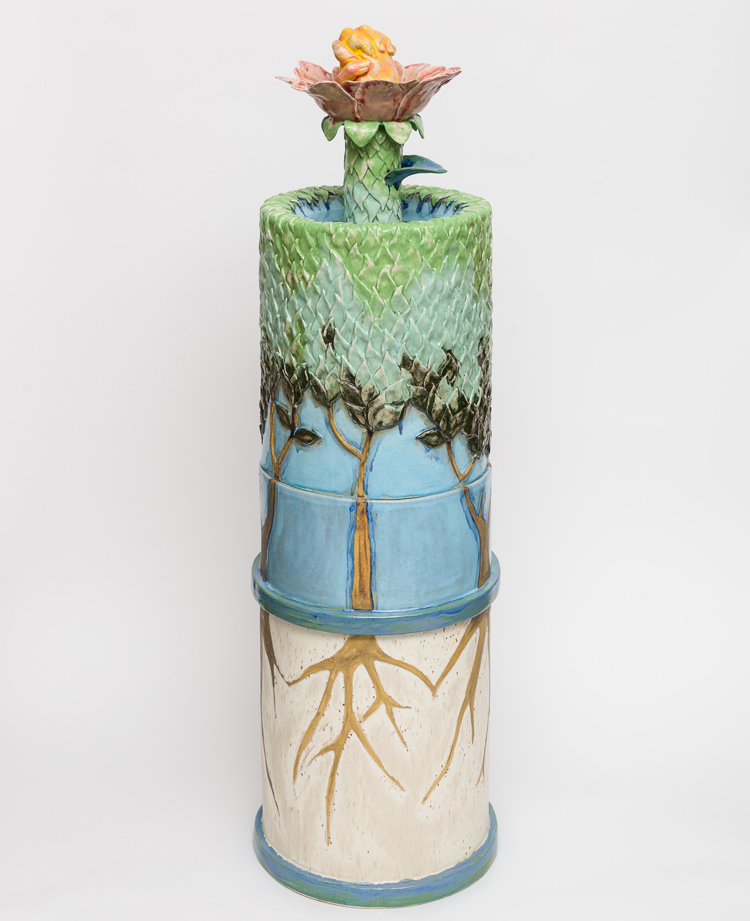
Jonathan Baldock, You & I are Earth, 2023. Courtesy the artist and Stephen Friedman Gallery. Photo © Mark Blower.
Another tall ceramic pillar, this one thicker, depicts a band of trees in the landscape. Beneath it, another band shows the trees’ roots linked in a kind of eternal dance, in a reference to the connectivity of our forest systems. This pillar is topped with an upturned ceramic “font” in the shape of a flower, which contains water, along with two clasped, pinkish clay hands. It is called You and I are Earth (2023).
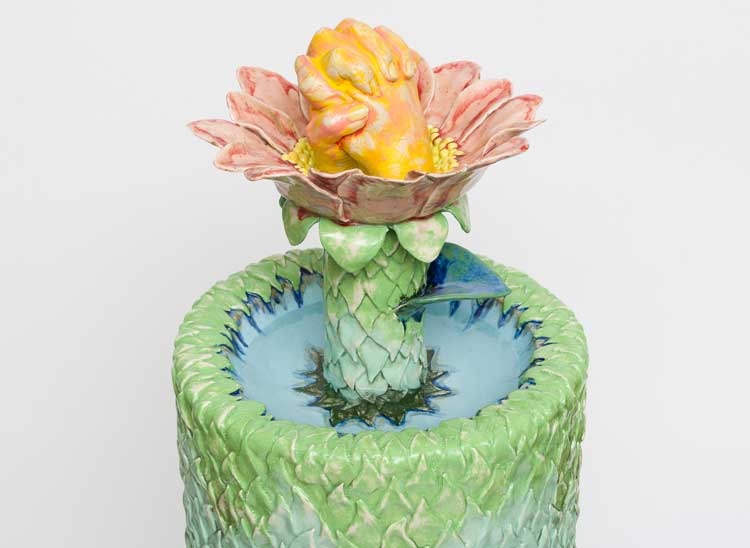
Jonathan Baldock, You & I are Earth, 2023. Courtesy the artist and Stephen Friedman Gallery. Photo © Mark Blower.
Coulson expands on the “touch wood” of the show’s title: “It’s about superstition and what we believe in. That ‘touch wood’ instinct seems to have come from a tradition of people touching a tree for luck. But there are two interpretations: you’re either touching something benevolent in the tree, or something less benevolent and you touch the tree to ward it off. Jonathan is saying there is fluidity in meaning and interpretation everywhere.”
,-2023-YSP_8.jpg)
Jonathan Baldock, Becoming a Plant (a hop), 2023. Courtesy the artist and Stephen Friedman Gallery. Photo © Mark Reeve, courtesy YSP.
This mixture of universal symbols, primitive and primal patterns and rituals is blended with Baldock’s personal stories and loved ones. A particularly touching ceramic figure, Becoming a Plant: a Hop (2023), comprises a column with two faces, one a replica of his, the other his mother’s. There are two hands – one his, one hers (with painted nails) – one raised up, the other pointing down. It is a Janus for our uncertain times. There is so much skill in the texture and treatment of this figure, in the crown of green leaves that surrounds their faces, the deep lapis lazuli matt glaze of the “torso” and the exquisite detail in features and skin. It is his personal family totem.
,-2023-YSP_4.jpg)
Jonathan Baldock, Becoming a Plant (a hop), 2023. Courtesy the artist and Stephen Friedman Gallery. Photo © Mark Reeves, courtesy YSP.
Huge consideration has gone into how all these pieces are displayed, the impact of their choreography with each other and the room around them. Baldock has painted fat arches on to the walls, replicating a glade of trees, with the arches filled in with a pale, sky blue, framed in leaf green. Coulson says: “He originally wanted them to be the same proportion as the arches that run down the nave of Wakefield Cathedral. But those are very tall and thin and didn’t suit the space. So, he squashed them down and in doing that he reflects architectures from different parts of the world.
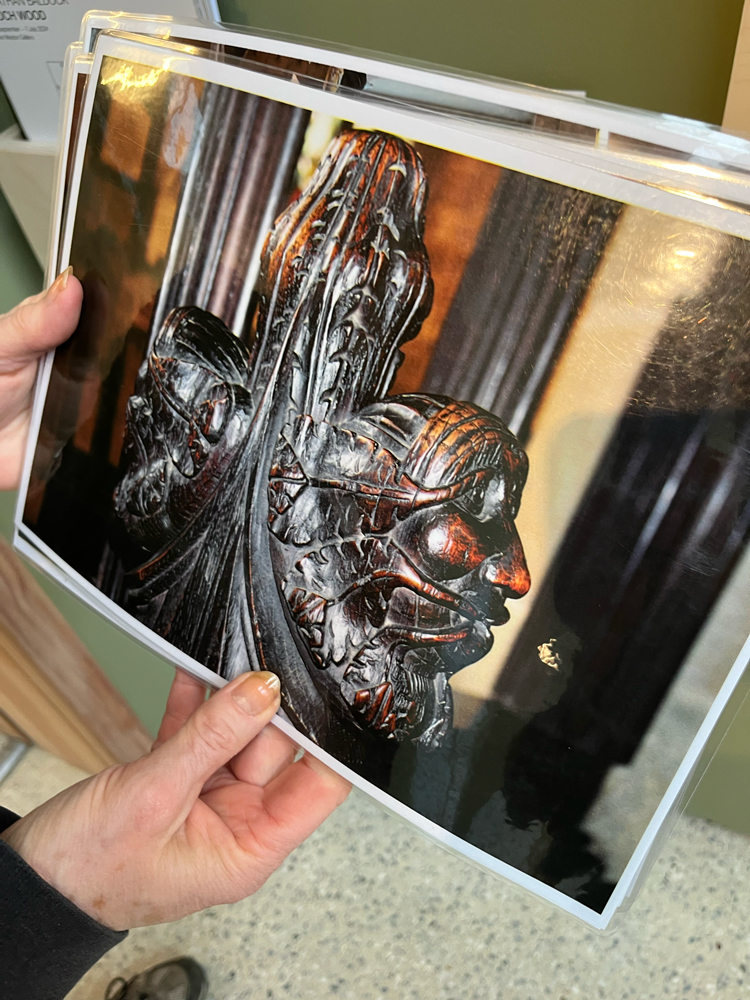
Photography of carvings from Wakefield Cathedral that inspired some works. Photo: Veronica Simpson.
It seems apt that the landscape will also dialogue through the windows as the show progresses through winter, spring and summer, as it ends in July 2024. And for a change, I don’t feel sorry for the gallery assistants who will have to listen to the accompanying soundscape for all that time. Luke Barton, the musician who created it, has blended a compelling mix including local birdsong recorded in the park, Morris dancers and their jingling music, the ambient noises of Wakefield cathedral, and a crackling, whispering background noise taken from the sound of plants and trees growing (probes were attached to translate electronic pulses into sound). It adds to the sense of mystery and connection across many boundaries, not least time and species.